Assessing the Impact of Grazing and Restoration Methods on Pannonian Grasslands
Abstract
1. Introduction
- Is grazing with Hungarian Grey cattle indeed the most suitable method for enhancing species composition in Pannonian dry grasslands, even with the application of various grassland restoration techniques?
- How do species richness and grassland composition vary with different restoration methods in terms of ecological quality and potential utilization?
- Will the effects of different grassland establishment techniques persist, and if so, to what extent, and how will they manifest in the grassland composition during two years of mowing followed by grazing management?
- How effective and economically viable was the use of direct seeding and alfalfa sowing on the restored areas?
2. Materials and Methods
2.1. Study Area
2.2. Sample Plots
2.3. Sampling
2.4. Data Analysis
- Perennial Species:
- Annual Species:
- Dwarf Shrubs:
3. Results
Results Based on Relative Ecological Indicators
4. Discussion
5. Conclusions
Supplementary Materials
Author Contributions
Funding
Data Availability Statement
Conflicts of Interest
References
- Maestre, F.T.; Le Bagousse-Pinguet, Y.; Delgado-Baquerizo, M.; Eldridge, D.J.; Saiz, H.; Berdugo, M.; Gozalo, B.; Ochoa, V.; Guirado, E.; García-Gómez, M.; et al. Grazing and ecosystem service delivery in global drylands. Science 2022, 378, 915–920. [Google Scholar] [CrossRef] [PubMed]
- Lyons, K.G.; Török, P.; Hermann, J.-M.; Kiehl, K.; Kirmer, A.; Kollmann, J.; Overbeck, G.E.; Tischew, S.; Allen, E.B.; Bakker, J.D.; et al. Challenges and opportunities for grassland restoration: A global perspective of best practices in the era of climate change. Glob. Ecol. Conserv. 2023, 46, e02612. [Google Scholar] [CrossRef]
- Price, J.N.; Sitters, J.; Ohlert, T.; Tognetti, P.M.; Brown, C.S.; Seabloom, E.W.; Borer, E.T.; Prober, S.M.; Bakker, E.S.; MacDougall, A.S.; et al. Evolutionary History of Grazing and Resources Determine Herbivore Exclusion Effects on Plant Diversity. Nat. Ecol. Evol. 2022, 6, 1290–1298. [Google Scholar] [CrossRef] [PubMed]
- Dengler, J.; Bergmeier, E.; Willner, W.; Chytrý, M. Towards a consistent classification of European grasslands. J. Veg. Sci. 2013, 16, 518–520. [Google Scholar] [CrossRef]
- Wilson, J.B.; Peet, R.K.; Dengler, J.; Pärtel, M. Plant species richness: The world records. J. Veg. Sci. 2012, 23, 796–802. [Google Scholar] [CrossRef]
- Mucina, L.; Bültmann, H.; Dierßen, K.; Theurillat, J.; Raus, T.; Čarni, A.; Šumberová, K.; Willner, W.; Dengler, J.; García, R.G.; et al. Vegetation of Europe: Hierarchical floristic classification system of plant, bryophyte, lichen, and algal communities. Appl. Veg. Sci. 2016, 19, 3–264. [Google Scholar] [CrossRef]
- Wesche, K.; Ambarlı, D.; Kamp, J.; Török, P.; Treiber, J.; Dengler, J. The Palaearctic steppe biome: A new synthesis. Biodivers. Conserv. 2016, 25, 2197–2231. [Google Scholar] [CrossRef]
- Myers, N.; Mittermeier, R.A.; Mittermeier, C.G.; da Fonseca, G.A.B.; Kent, J. Biodiversity hotspots for conservation priorities. Nature 2000, 403, 853–858. [Google Scholar] [CrossRef]
- Habel, J.C.; Dengler, J.; Janišová, M.; Török, P.; Wellstein, C.; Wiezik, M. European grassland ecosystems: Threatened hotspots of biodiversity. Biodivers. Conserv. 2013, 22, 2131–2138. [Google Scholar] [CrossRef]
- Cremene, C.; Groza, G.; Rakosy, L.; Schileyko, A.A.; Baur, A.; Erhardt, A.; Baur, B. Alterations of steppe-like grasslands in Eastern Europe: A threat to regional biodiversity hotspots. Conserv. Biol. 2005, 19, 1606–1618. Available online: http://edoc.unibas.ch/dok/A5249054 (accessed on 4 April 2024). [CrossRef]
- Conant, R.T.; Paustian, K.; Elliott, E.T. Grassland management and conversion into grassland: Effect on soil carbon. Ecol. Appl. 2001, 11, 343–355. Available online: https://api.semanticscholar.org/CorpusID:84726423 (accessed on 4 April 2024). [CrossRef]
- Hobohm, C.; Bruchmann, I. Endemische Gefäßpflanzen und ihre Habitate in Europa: Plädoyer für den Schutz der Grasland-Ökosysteme. Berichte Der Reinhold-Tüxen-Ges. 2009, 21, 142–161. [Google Scholar]
- Collins, S.L.; Chung, Y.A.; Baur, L.E.; Hallmark, A.; Ohlert, T.J.; Rudgers, J.A. Press–pulse interactions and long-term community dynamics in a Chihuahuan Desert grassland. J. Veg. Sci. 2020, 31, 722–732. [Google Scholar] [CrossRef]
- Cleland, E.E.; Collins, S.L.; Dickson, T.L.; Farrer, E.C.; Gross, K.L.; Gherardi, L.A.; Hallett, L.M.; Hobbs, R.J.; Hsu, J.S.; Turnbull, L.; et al. Sensitivity of grassland plant community composition to spatial vs. temporal variation in precipitation. Ecology 2013, 94, 1687–1696. [Google Scholar] [CrossRef] [PubMed]
- Harrison, S.P.; Gornish, E.S.; Copeland, S. Climate-driven diversity loss in a grassland community. Proc. Natl. Acad. Sci. USA 2015, 112, 8672–8677. [Google Scholar] [CrossRef]
- Jonas, J.L.; Buhl, D.A.; Symstad, A.J. Impacts of weather on long-term patterns of plant richness and diversity vary with location and management. Ecology 2015, 96, 2417–2432. [Google Scholar] [CrossRef]
- Bartha, S.; Szabó, G.; Csete, S.; Purger, D.; Házi, J.; Csathó, A.I.; Campetella, G.; Canullo, R.; Chelli, S.; Tsakalos, J.L.; et al. High-Resolution Transect Sampling and Multiple Scale Diversity Analyses for Evaluating Grassland Resilience to Climatic Extremes. Land 2022, 11, 378. [Google Scholar] [CrossRef]
- Dong, S.; Shang, Z.; Gao, J.; Boone, R.B. Enhancing sustainability of grassland ecosystems through ecological restoration and grazing management in an era of climate change on Qinghai-Tibetan Plateau. Agric. Ecosyst. Environ. 2020, 287, 106684. [Google Scholar] [CrossRef]
- Yan, Y.; Liu, X.; Wen, Y.; Ou, J. Quantitative analysis of the contributions of climatic and human factors to grassland productivity in northern China. Ecol. Indic. 2019, 103, 542–553. [Google Scholar] [CrossRef]
- Zhou, G.; Zhou, X.; He, Y.; Shao, J.; Hu, Z.; Liu, R.; Hosseinibai, S. Grazing intensity significantly affects belowground carbon and nitrogen cycling in grassland ecosystems: A meta-analysis. Glob. Change Biol. 2017, 23, 1167–1179. [Google Scholar] [CrossRef]
- Liu, Y.Y.; Evans, J.P.; McCabe, M.F.; De Jeu, R.A.; van Dijk, A.I.; Dolman, A.J.; Saizen, I. Changing climate and overgrazing are decimating Mongolian steppes. PLoS ONE 2013, 8, e57599. [Google Scholar] [CrossRef] [PubMed]
- Bengtsson, J.; Bullock, J.M.; Egoh, B.; Everson, C.; Everson, T.; O’Connor, T.; O’Farrell, P.J.; Smith, H.G.; Lindborg, R. Grasslands—More important for ecosystem services than you might think. Ecosphere 2019, 10, e02582 . [Google Scholar] [CrossRef]
- Zhang, M.; Delgado-Baquerizo, M.; Li, G.; Isbell, F.; Wang, Y.; Hautier, Y.; Wang, Y.; Xiao, Y.; Cai, J.; Pan, X.; et al. Experimental impacts of grazing on grassland biodiversity and function are explained by aridity. Nat Commun. 2023, 14, 5040. [Google Scholar] [CrossRef] [PubMed]
- Kerekes, V.; Ozogány, K.; Sándor, S.; Vegvari, Z.; Czető, C.; Nyírő, B.; Szabados, T.; Széles, L.; Barta, Z. Analysis habitat use, activity, and bogy condition scores of condition scores of Przewalski’s horses ib Hortobágy National Park, Hungary. Nat. Conserv. Res. 2019, 4 (Suppl. S2), 31–40. [Google Scholar] [CrossRef]
- Du, H.Q.; Zuo, X.A.; Li, S.; Wang, T.; Xue, X. Wind erosion changes induced by different grazing intensities in the desert steppe, Northern China. Agr. Ecosyst. Environ. 2019, 274, 1–13. [Google Scholar] [CrossRef]
- Zheng, M.; Song, J.; Ru, J.; Zhou, Z.; Zhong, M.; Jiang, L.; Hui, D.; Wan, S. Effects of grazing, wind erosion, and dust deposition on plant community composition and structure in a temperate steppe. Ecosystems 2021, 24, 403–420. [Google Scholar] [CrossRef]
- Török, P.; Dengler, J. Palaearctic Grasslands in Transition: Overarching Patterns and Future Prospects. Grasslands of the World: Diversity, Management and Conservation. In Grasslands of the World: Diversity, Management and Conservation; CRC Press: Boca Raton, FL, USA, 2018; pp. 15–26. [Google Scholar]
- Biró, M.; Bölöni, J.; Molnár, Z. Use of long-term data to evaluate loss and endangerment status of Natura 2000 habitats and effects of protected areas. Conserv. Biol. 2018, 32, 660–671. [Google Scholar] [CrossRef]
- Erdős, L.; Ambarlı, D.; Anenkhonov, O.A.; Bátori, Z.; Cserhalmi, D.; Kiss, M.; Kröel-Dulay, G.; Liu, H.; Magnes, M.; Molnár, Z.; et al. The edge of two worlds: A new review and synthesis on Eurasian forest-steppes. Appl. Veg. Sci. 2018, 21, 345–362. [Google Scholar] [CrossRef]
- Kuemmerle, T.; Levers, C.; Erb, K.; Estel, S.; Jepsen, M.R.; Müller, D.; Plutzar, C.; Stürck, J.; Verkerk, P.J.; Verburg, P.H.; et al. Hotspots of land use change in Europe. Environ. Res. Lett 2016, 11, 064020. [Google Scholar] [CrossRef]
- Watson, J.E.; Jones, K.R.; Fuller, R.A.; Di Marco, M.; Segan, D.B.; Butchart, S.H.; Allan, J.R.; McDonald-Madden, E.; Venter, O. Persistent disparities between recent rates of habitat conversion and protection and implications for future global conservation targets. Conserv. Lett. 2016, 9, 413–421. [Google Scholar] [CrossRef]
- Török, P.; Kelemen, A.; Valkó, O.; Deák, B.; Lukács, B.; Tóthmérész, B. Lucerne dominated fields recover native grass diversity without intensive management actions. J. Appl. Ecol. 2011, 48, 257–264. [Google Scholar] [CrossRef]
- Jongepierová, I.; Mitchley, J.; Tzanopoulos, J. A field experiment to recreate species rich hay meadows using regional seed mixtures. Biol. Conserv. 2007, 139, 297–305. [Google Scholar] [CrossRef]
- Török, P.; Deák, B.; Vida, E.; Valkó, O.; Lengyel Sz Tóthmérész, B. Restoring grassland biodiversity: Sowing low-diversity seed mixtures can lead to rapid favourable changes. Biol. Conserv. 2010, 143, 806–812. [Google Scholar] [CrossRef]
- Török, P.; Miglécz, T.; Valkó, O.; Kelemen, A.; Tóth, K.; Lengyel, S.; Tóthmérész, B. Fast recovery of grassland vegetation by a combination of seed mixture sowing and low-diversity hay transfer. Ecol. Eng. 2012, 44, 133–138. [Google Scholar] [CrossRef]
- Wagner, M.; Hulmes, S.; Hulmes, L.; Redhead, J.W.; Nowakowski, M.; Pywell, R.F. Green hay transfer for grassland restoration: Species capture and establishment. Restor. Ecol. 2020, 29, e13259. [Google Scholar] [CrossRef]
- Rasran, L.; Vogt, K.; Jensen, K. Seed content and conservation evaluation of hay material of fen grasslands. J. Nat. Conserv. 2006, 14, 34–45. [Google Scholar] [CrossRef]
- Donath, T.; Bissels, S.; Hölzel, N.; Otte, A. Large scale application of diaspore transfer with plant material in resoration practice- Impact of seed and microsite limitation. Biol. Conserv. 2007, 138, 224–234. [Google Scholar] [CrossRef]
- Nagy, G. A gyephasználati lehetőségek sokoldalúsága. Gyepgazdálkodási Közlemények 2008, 6, 5–7. [Google Scholar]
- Mijnsbrugge, V.K.; Bischoff, A.; Smith, B. A question of origin: Where and how to collect seed for ecological restoration. Basic Appl. Ecol. 2010, 11, 300–311. [Google Scholar] [CrossRef]
- Kaulfuß, F.; Rosbakh, S.; Reisch, C. Grassland restoration by local seed mixtures: New evidence from a practical 15-year restoration study. Appl. Veg. Sci. 2022, 25, e12652. [Google Scholar] [CrossRef]
- Billeter, R.; Peintinger, M.; Diemer, M. Restoration of montane fen meadows by mowing remains possible after 4–35 years of abandonment. Acta Bot. Helv. 2007, 117, 1–13. [Google Scholar] [CrossRef]
- Házi, J.; Penksza, K.; Bartha, S.; Hufnagel, L.; Tóth, A.; Gyuricza, C.; Szentes, S. Cut mowing and grazing Effects with grey cattle on plant species composition in case of Pannon wet grasslands. Appl. Ecol. Environ. Res. 2012, 10, 223–231. [Google Scholar] [CrossRef]
- Kiss, T.; Lévai, P.; Ferencz, Á.; Szentes, S.; Hufnagel, L.; Nagy, A.; Balogh, Á.; Pintér, O.; Saláta, D.; Házi, J.; et al. Change of composition and diversity of species and grassland management between different grazing intensity—In Pannonian dry and wet grasslands. Appl. Ecol. Environ. Res. 2011, 9, 197–230. [Google Scholar] [CrossRef]
- Aboling, S. Do Poisonous Plants in Pastures Communicate Their Toxicity? Meta-Study and Evaluation of Poisoning Cases in Central Europe. Animals 2023, 13, 3795. [Google Scholar] [CrossRef] [PubMed]
- Hessle, A.; Rutter, M.; Wallin, K. Effect of breed, season and pasture moisture gradient on foraging behaviour in cattle on semi-natural grasslands. Appl. Anim. Behav. Sci. 2008, 111, 108–119. [Google Scholar] [CrossRef]
- Hessle, A.; Wissman, J.; Bertilsson, J.; Burstedt, E. Effect of breed of cattle and season on diet selection and defoliation of competitive plant species in semi-natural grasslands. Grass Forage Sci. 2008, 63, 86–93. [Google Scholar] [CrossRef]
- Pauler, C.M.; Isselstein, J.; Braunbeck, T.; Schneider, M.K. Influence of Highland and Production-Oriented Cattle Breeds on Pasture Vegetation: A Pairwise Assessment across Broad Environmental Gradients. Agric. Ecosyst. Environ. 2019, 284, 106585. [Google Scholar] [CrossRef]
- Pauler, C.M.; Isselstein, J.; Suter, M.; Berard, J.; Braunbeck, T.; Schneider, M.K. Choosy grazers: Influence of plant traits on forage selection by three cattle breeds. Funct. Ecol. 2020, 34, 980–992. [Google Scholar] [CrossRef]
- Spiegal, S.; Estell, R.E.; Cibils, A.F.; James, D.K.; Peinetti, H.R.; Browning, D.M.; Romig, K.B.; Gonzalez, A.L.; Lyons, A.J.; Bestelmeyer, B.T. Seasonal divergence of landscape use by heritage and conventional cattle on desert rangeland. Rangel. Ecol. Manag. 2019, 72, 590–601. [Google Scholar] [CrossRef]
- Poetsch, E.M.; Resch, R.; Haeusler, J.; Steinwidder, A. Productivity and floristic diversity of a continuous grazing system on short swards in mountainous regions of Austria. Grassl. Sci. Eur. 2010, 19, 139–141. [Google Scholar]
- Mandaluniz, N.; Aldezabal, A.; Oregui, L.M. Diet selection of beef cattle on Atlantic grassland-heathland mosaic: Are heathers more preferred than expected? Livest. Sci. 2011, 138, 49–55. [Google Scholar] [CrossRef]
- Fraser, M.D.; Theobald, V.J.; Griffiths, J.B.; Morris, S.M.; Moorby, J.M. Comparative diet selection by cattle and sheep grazing two contrasting heathland communities. Agric. Ecosyst. Environ. 2009, 129, 182–192. [Google Scholar] [CrossRef]
- Koczura, M.; Martin, B.; Bouchon, M.; Turille, G.; Berard, J.; Farruggia, A.; Kreuzer, M.; Coppa, M. Grazing behaviour of dairy cows on biodiverse mountain pastures is more influenced by slope than cow breed. Animal 2019, 13, 2594–2602. [Google Scholar] [CrossRef]
- De Vries, W.M.F.; Daleboudt, C. Foraging strategy of cattle in patchy grassland. Oecologia 1994, 100, 98–106. [Google Scholar] [CrossRef] [PubMed]
- McGeough, E.J.; Cattani, D.J.; Koscielny, Z.; Hewitt, B.; Ominski, K.H. Annual and perennial forages for fall/winter grazing in western Canada. Can. J. Plant Sci. 2018, 98, 247–254. [Google Scholar] [CrossRef]
- Dövényi, Z. (szerk.) Magyarország Kistájaink a Katasztere, 2nd ed.; Akadémiai Kiadó: Budapest, Hungary, 2010. [Google Scholar]
- Boglárka, U.; Lajos, J.; László, S.; Levente, I.V.; Penksza, A.; Szentes, S.; Házi, J.; Sutyinszki, Z.; Tth, A.; Penksza, K. Telepített és felújított gyepek, parlagok összehasonlító botanikai, gyepgazdálkodási vizsgálata [Coenological and (economical) forage value comparison of seminatural and man-made grasslands in Hungary]. Anim. Welf. Ethol. Hous. Syst. 2014, 10, 85–106. [Google Scholar]
- Braun-Blanquet, J. Pflanzensoziologie; Wien: New York, NY, USA, 1964; pp. 2–865. [Google Scholar]
- Király, G. Új Magyar Füvészkönyv. Magyarország Hajtásos Növényei. határozókulcsok [New Hungarian Herbal. The Vascular Plants of Hungary. Identification Key]. Király, G., Ed.; Aggteleki Nemzeti Park Igazgatóság: Jósvafő, Hungary, 2009. [Google Scholar]
- Simon, T. A Magyar Edényes Flóra Határozója [Definier of the Hungarian Vascular Flora]; Tankönyvkiadó: Budapest, Hungary, 2000. [Google Scholar]
- Borhidi, A. Social behavior types, the naturalness and relative ecological indicator values of the higher plants in the Hungarian Flora. Acta Bot. Acad. Sci. Hung. 1995, 39, 97–181. [Google Scholar]
- Pignatti, S. Valori di bioindicazione delle piante vascolari della flora d’Italia. Braun Blanquetia 2005, 39, 1–97. [Google Scholar]
- Briemle, G.; Nitsche, S.; Nitsche, L. Nutzungswertzahlen für Gefäßpflanzen des Grünlandes. Schriftenreihe für Vegetationskunde; Bundesamt für Naturschutz: Bonn, Germany, 2005; pp. 203–225. [Google Scholar]
- Házi, J.; Penksza, K.; Barczi, A.; Szentes, S.; Pápay, G. Effects of Long-Term Mowing on Biomass Composition in Pannonian Dry Grasslands. Agronomy 2022, 12, 1107. [Google Scholar] [CrossRef]
- Balázs, F. A Gyepek Botanikai és Gazdasági Értékelése [Botanical and Economic Assessment of Grasslands]; Mezőgazdasági Kiadó: Budapest, Hungary, 1960; pp. 3–28. [Google Scholar]
- Klapp, E.; Boeker, P.; König, F.; Stählin, A. Wertzahlen der Grünlandpflanzen. Grünland 1953, 2, 38–40. [Google Scholar]
- Ushey, K.; Allaire, J.; Tang, Y. Reticulate: Interface to ‘Python’. R Package Version 1.38.0, 2024. Available online: https://github.com/rstudio/reticulate (accessed on 13 May 2024).
- Waskom, M. Seaborn: Statistical data visualization. J. Open Source Softw. 2021, 6, 3021. [Google Scholar] [CrossRef]
- Bartholy, J.; Pongrácz, R. Tendencies of extreme climate indicates based on daily precipitation in the Carpathian Basin for the 20th century. Időjárás 2005, 109, 1–20. [Google Scholar]
- Bartholy, J.; Pongrácz, R. Comparing tendencies of some temperature and precipitation on global and regional scales. Időjárás 2006, 110, 35–48. [Google Scholar]
- Bartholy, J.; Pongrácz, R. Regional analysis of extreme temperature and precipitation indices for the Carpathian Basin from 1946 to 2001. Glob. Planet. Change 2007, 57, 83–95. [Google Scholar] [CrossRef]
- Peco, B.; Sánchez, A.M.; Azcárate, F.M. Abandonment in grazing systems: Consequences for vegetation and soil. Agric. Ecosyst. Environ. 2006, 113, 284–294. [Google Scholar] [CrossRef]
- Catorci, A.; Cesaretti, S.; Gatti, R. Biodiversity conservation: Geosynphytosociology as a tool of analysis and modelling of grassland systems. Hacquetia 2009, 8, 129–146. Available online: https://ojs.zrc-sazu.si/hacquetia/article/view/2909 (accessed on 4 April 2024). [CrossRef]
- Catorci, A.; Piermarteri, K.; Penksza, K.; Házi, J.; Tardella, F.M. Filtering effect of temporal niche fluctuation and amplitude of environmental variations on the trait-related flowering patterns: Lesson from sub-Mediterranean grasslands. Sci. Rep. 2017, 7, 12034. [Google Scholar] [CrossRef]
- Borhidi, A.; Kevey, B.; Lendvai, G.; Seregélyes, T. Plant Communities of Hungary; Akadémiai Kiadó: Budapest, Hungary, 2012. [Google Scholar]
- Deák, B.; Tóthmérész, B. A kaszálás hatása a Hortobágy Nyírőlapos csetkákás társulásában [Effect of cutting on a Bolboschoenetum maritime eleochariosum association in the Nyirőlapos (Hortobágy)]. Természetvédelmi Közlemények 2007, 13, 179–186. [Google Scholar]
- Deák, B.; Valkó, O.; Kelemen, A.; Török, P.; Miglécz, T.; Ölvedi, T.; Lengyel Sz Tóthmérész, B. Litter and graminoid biomass accumulation suppresses weedy forbs in grassland restoration. Plant Biosyst. 2011, 145, 730–737. [Google Scholar] [CrossRef]
- Prach, K.; Pyšek, P. Using spontaneous succession for restoration of human-disturbed habitats: Experience from Central Europe. Ecol. Eng. 2001, 17, 55–62. [Google Scholar] [CrossRef]
- McLachlan, S.M.; Knispel, A.L. Assessment of long-term tallgrass prairie restoration in Manitoba, Canada. Biol. Conserv. 2005, 124, 75–88. [Google Scholar] [CrossRef]
- Tóth, E.; Deák, B.; Valkó, O.; Kelemen, A.; Miglécz, T.; Tóthmérész, B.; Török, P. Livestock type is more crucial than grazing intensity:traditional cattle and sheep grazing in short-grass steppes. Land Degrad. Dev. 2018, 29, 231–239. [Google Scholar] [CrossRef]
- Tälle, M.; Deák, B.; Poschlod, P.; Valkó, O.; Westerberg, L.; Milberg, P. Grazing vs. mowing: A meta-analysis of biodiversity benefits for grassland management. Agric. Ecosyst. Environ. 2016, 222, 200–212. [Google Scholar] [CrossRef]
- Török, P.; Lindborg, R.; Eldridge, D.; Pakeman, R. Grazing effects on vegetation: Biodiversity, management, and restoration. Appl. Veg. Sci. 2024, 27, e12794. [Google Scholar] [CrossRef]
- Ding, J.; Eldridge, D.J. The success of woody plant removal depends on encroachment stage and plant traits. Nat. Plants 2023, 9, 58–67. [Google Scholar] [CrossRef]
- Carboni, L.J.; Yahdjian, L.; Oñatibia, G.R. Effects of livestock grazing intensification on plant communities of Patagonian drylands increase with increasing aridity. Appl. Veg. Sci. 2023, 26, e12754. [Google Scholar] [CrossRef]
- Rodríguez, A.; Ibanez, M.; Chocarro, C.; Sebastià, M.T. Livestock species rather than grazing intensity shape plant guild proportions in interaction with multiple environmental drivers in grassland from the Pyrenees. Appl. Veg. Sci. 2023, 26, e12724. [Google Scholar] [CrossRef]
- Kovacsics-Vári, G.; Sonkoly, J.; Tóth, K.; McIntosh-Buday, A.; Cando, P.D.; Törő-Szijgyártó, V.; Balogh, N.; Suntaxi, L.R.G.; Ami, F.D.E.; Demeter, L.; et al. Intensity-dependent effects of cattle and sheep grazing in sand grasslands—Does livestock type really matter? Appl. Veg. Sci. 2023, 26, e12727. [Google Scholar] [CrossRef]
- Scott, B.; Nelson, M.; Coon, J.J.; Schacht, W.H.; Miller, J.R. Cattle select against the invasive grass tall fescue in heterogeneous pastures managed with prescribed fire. Grass Forage Sci. 2019, 74, 486–495. [Google Scholar] [CrossRef]
- Tulloch, A.I.T.; Healy, A.; Silcock, J.; Wardle, G.M.; Dickman, C.R.; Frank, A.S.K.; Aubault, H.; Barton, K.; Greenville, A.C. Long-term livestock exclusion increases plant richness and reproductive capacity in arid woodlands. Ecol. Appl. 2023, 33, e2909. [Google Scholar] [CrossRef]
- Szemán, L. Ökológiai Gyepgazdálkodás [Ecological Grassland Management]. In Ökológiai Gazdálkodás: Általános Kérdések, Növénytermesztés, Állattenyésztés; Radics, L., Ed.; Dinasztia: Budapest-Gödöllő, Hungary, 2001; pp. 153–166. [Google Scholar]
- Amiaud, B.; Touzard, B.; Bonis, A.; Bouzillé, J.B. After grazing exclusion, is there any modification of strategy for two guerrilla species: Elymus repens (L.) Gould and Agrostis stolonifera (L.)? Plant Ecol. 2008, 197, 107–117. [Google Scholar] [CrossRef]
- Zimmermann, Z.; Szabó, G.; Bartha, S.; Szentes, S.; Penksza, K. Juhlegeltetés hatásainak természetvédelmi célú vizsgálata legelt és művelésből kivont gyepek növényzetére. AWETH 2011, 7, 234–262. [Google Scholar]
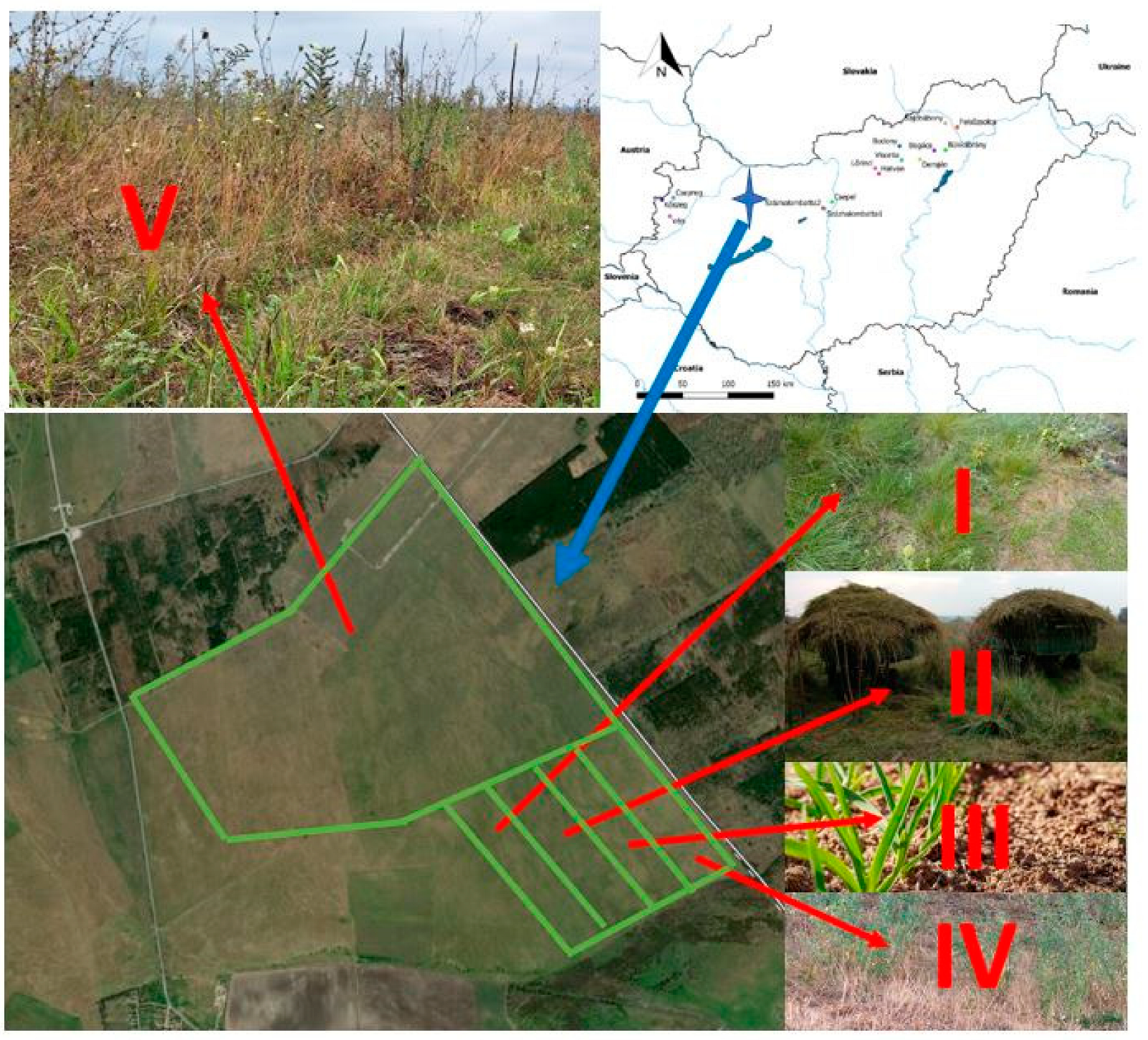
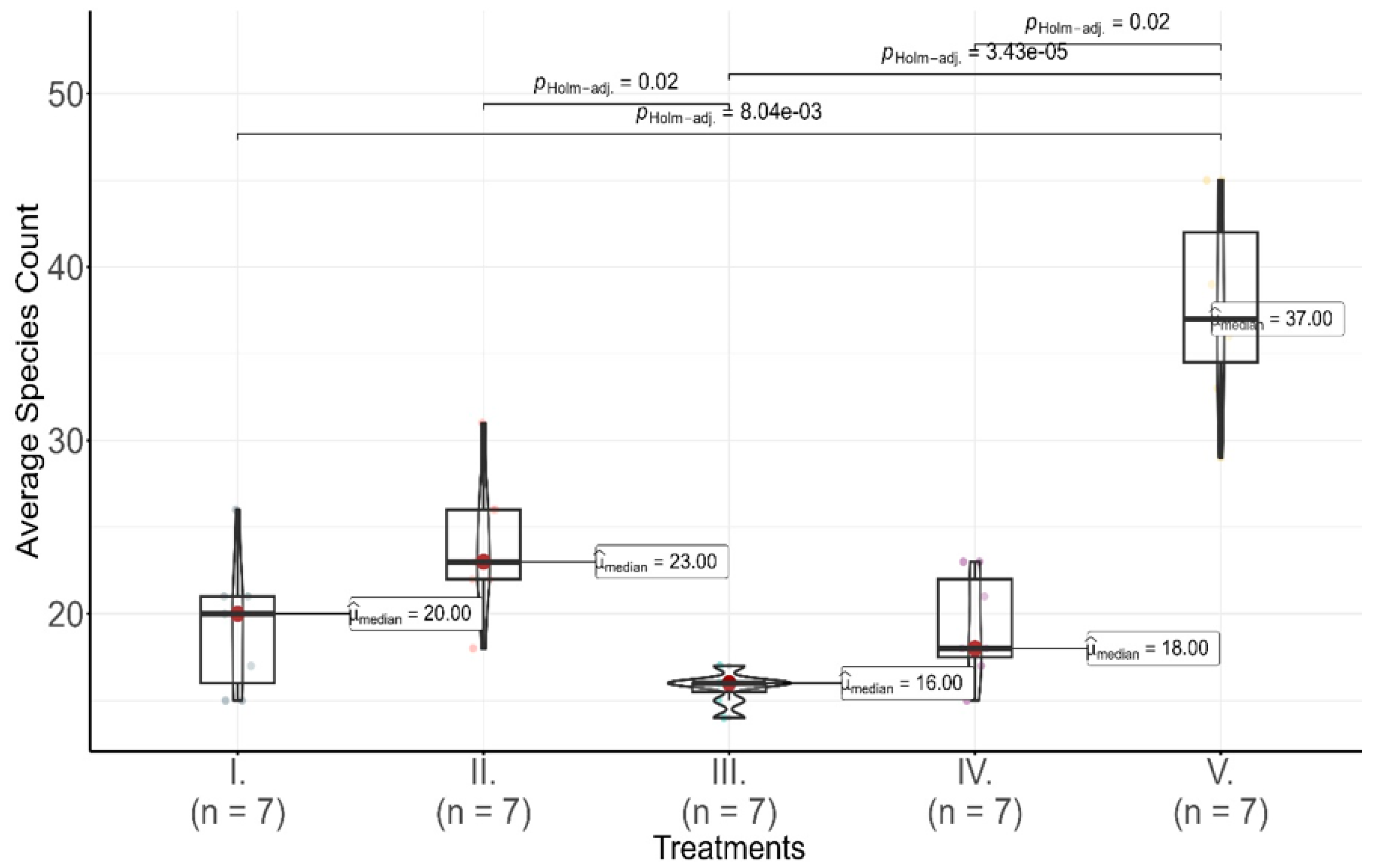
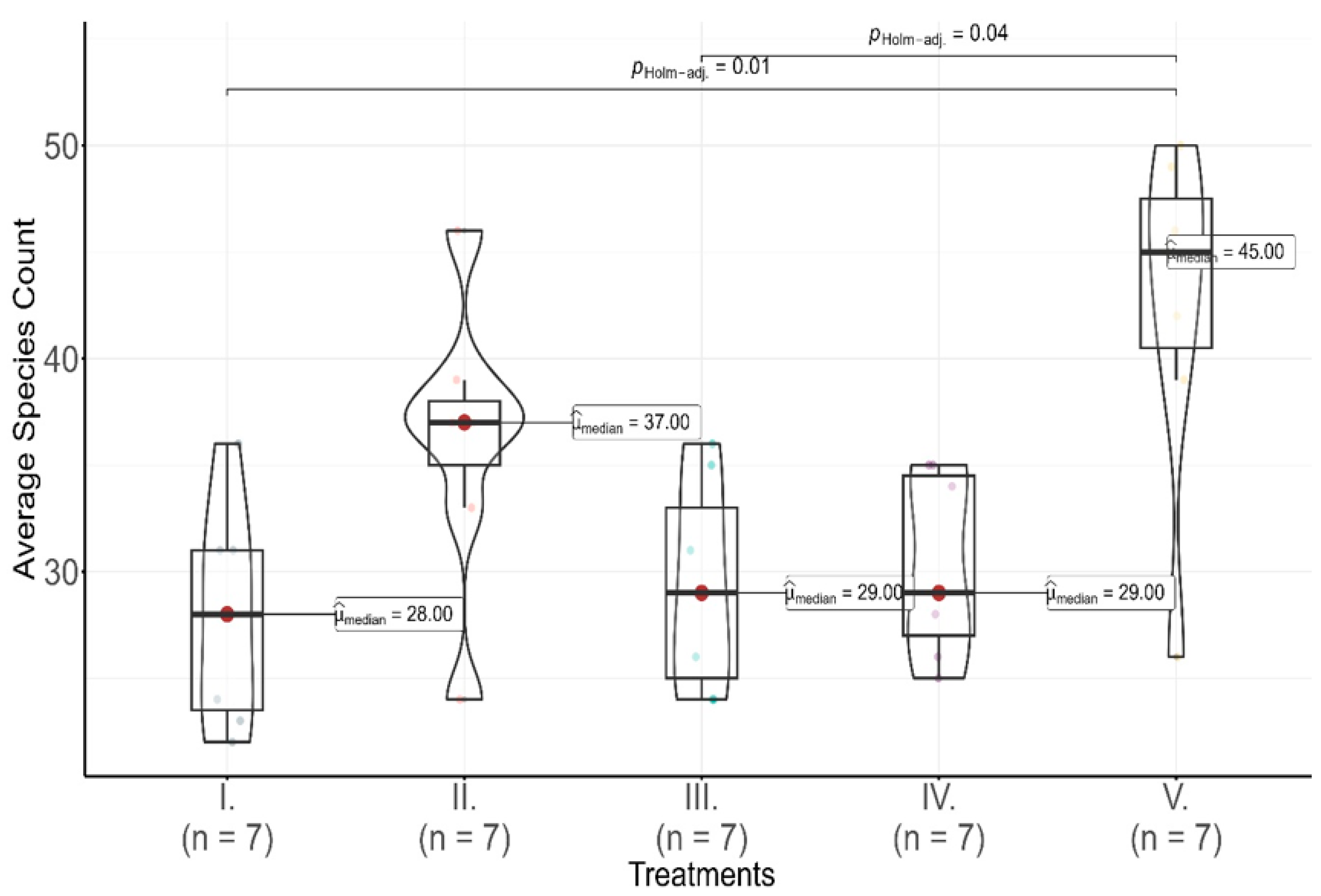
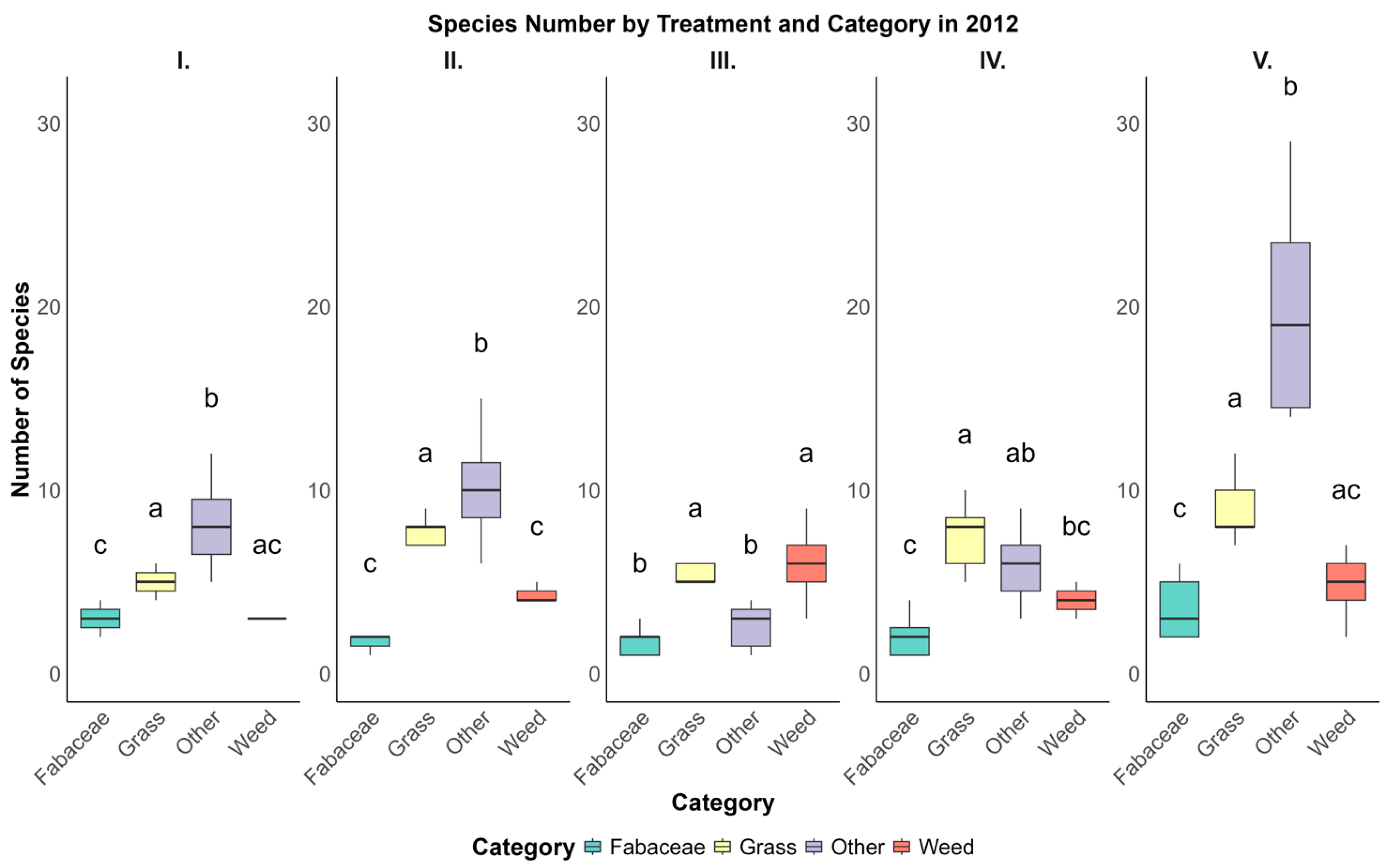
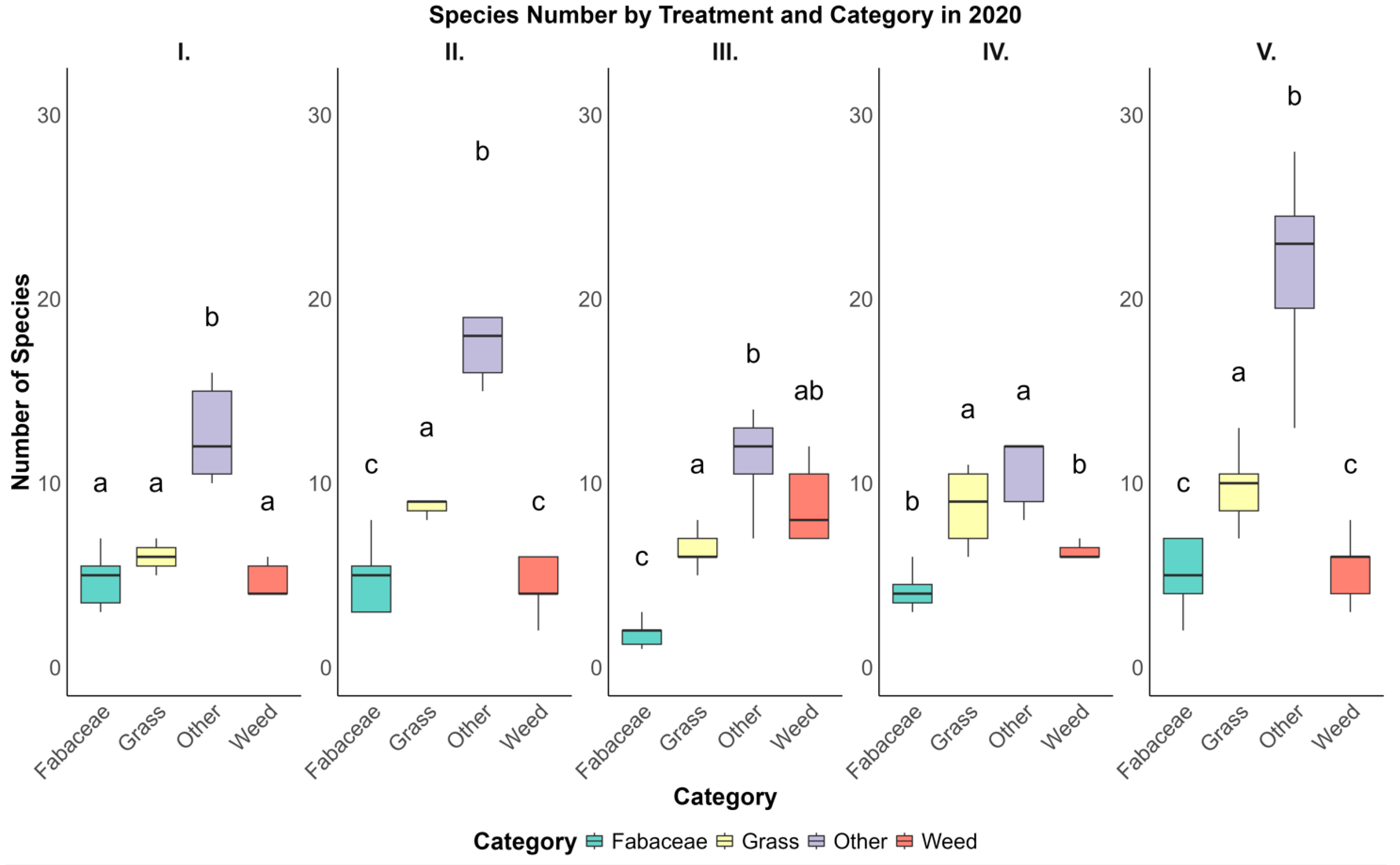



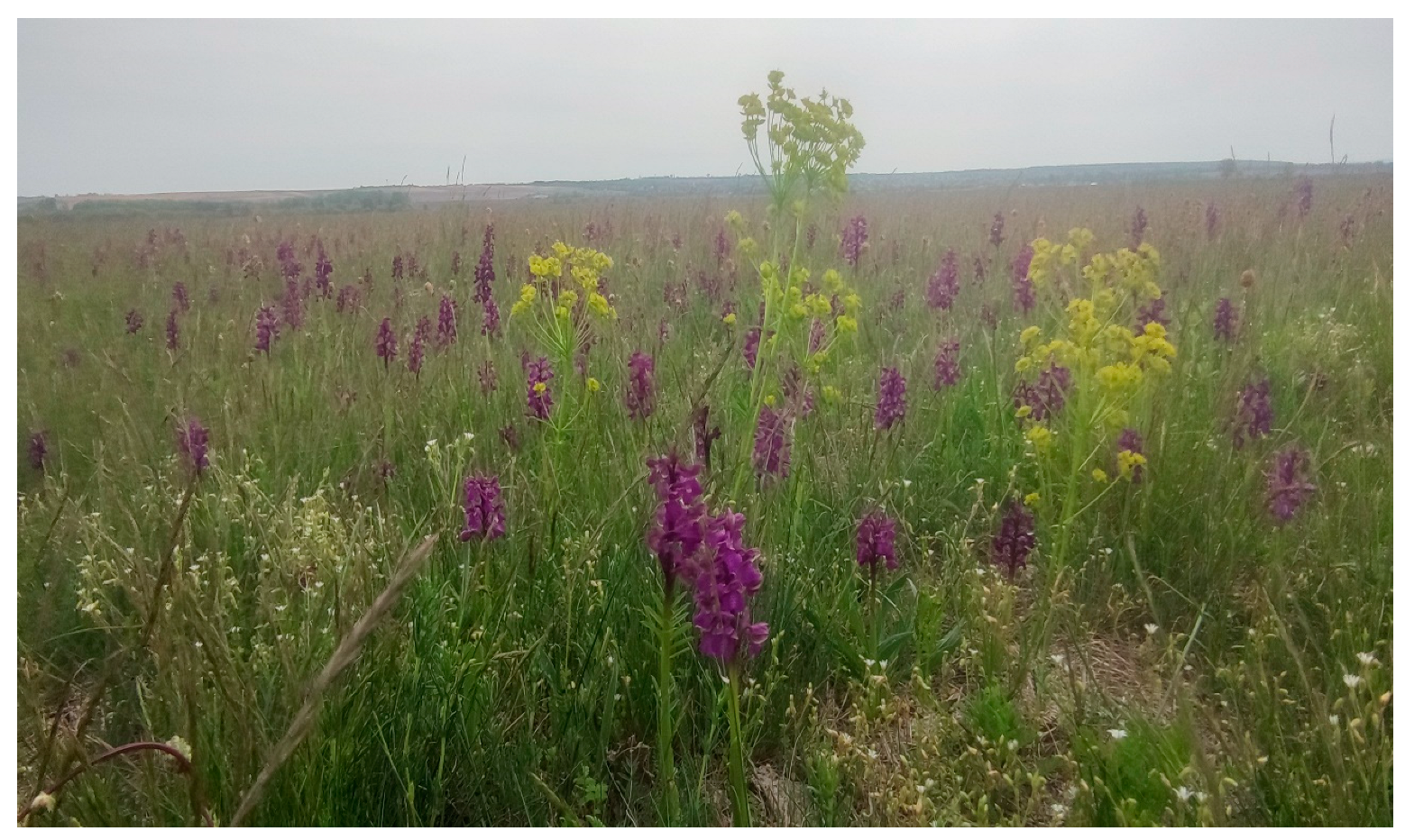
| Sample Areas | I | I | II | II | III | III | IV | IV | V | V |
|---|---|---|---|---|---|---|---|---|---|---|
| study years | 2012 | 2020 | 2012 | 2020 | 2012 | 2020 | 2012 | 2020 | 2012 | 2020 |
| height (cm) | 20 | 25 | 28 | 30 | 40 | 30 | 35 | 25 | 30 | 30 |
| green mass t/ha | 5.4 | 9.4 | 4.9 | 14.1 | 6.5 | 10.0 | 8.6 | 7.0 | 9.5 | 14.8 |
Disclaimer/Publisher’s Note: The statements, opinions and data contained in all publications are solely those of the individual author(s) and contributor(s) and not of MDPI and/or the editor(s). MDPI and/or the editor(s) disclaim responsibility for any injury to people or property resulting from any ideas, methods, instructions or products referred to in the content. |
© 2024 by the authors. Licensee MDPI, Basel, Switzerland. This article is an open access article distributed under the terms and conditions of the Creative Commons Attribution (CC BY) license (https://creativecommons.org/licenses/by/4.0/).
Share and Cite
Szentes, S.; Kevi, A.; Wagenhoffer, Z.; Saláta-Falusi, E.; Pajor, F.; Berke, J.; Turcsányi-Járdi, I.; Penksza, P.; Kunos, V.; Kende, Z.; et al. Assessing the Impact of Grazing and Restoration Methods on Pannonian Grasslands. Land 2024, 13, 2135. https://doi.org/10.3390/land13122135
Szentes S, Kevi A, Wagenhoffer Z, Saláta-Falusi E, Pajor F, Berke J, Turcsányi-Járdi I, Penksza P, Kunos V, Kende Z, et al. Assessing the Impact of Grazing and Restoration Methods on Pannonian Grasslands. Land. 2024; 13(12):2135. https://doi.org/10.3390/land13122135
Chicago/Turabian StyleSzentes, Szilárd, Andrea Kevi, Zsombor Wagenhoffer, Eszter Saláta-Falusi, Ferenc Pajor, József Berke, Ildikó Turcsányi-Járdi, Péter Penksza, Viola Kunos, Zoltán Kende, and et al. 2024. "Assessing the Impact of Grazing and Restoration Methods on Pannonian Grasslands" Land 13, no. 12: 2135. https://doi.org/10.3390/land13122135
APA StyleSzentes, S., Kevi, A., Wagenhoffer, Z., Saláta-Falusi, E., Pajor, F., Berke, J., Turcsányi-Járdi, I., Penksza, P., Kunos, V., Kende, Z., & Penksza, K. (2024). Assessing the Impact of Grazing and Restoration Methods on Pannonian Grasslands. Land, 13(12), 2135. https://doi.org/10.3390/land13122135



_Kazoglou.png)






